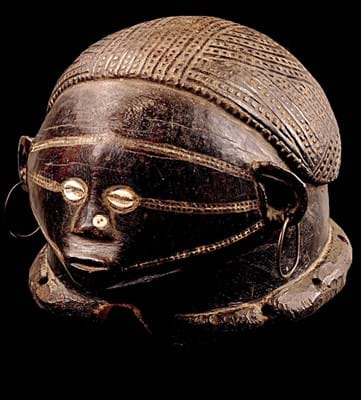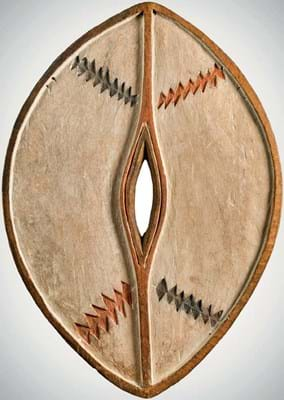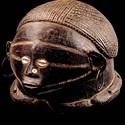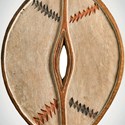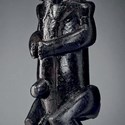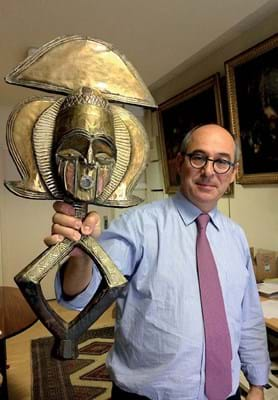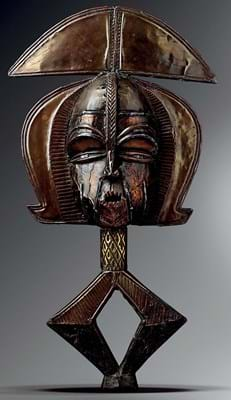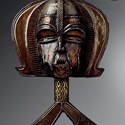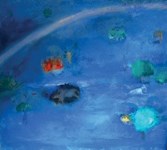The internet – with its ability to connect buyers and sellers and provide information on esoteric subject matter – has been key. Whether it comes from remote Pacific Islands, the cold climates of northernmost America or the heat of central Africa, tribal art is big business.
There are still major centres for trading this material. In terms of auctions, these are now New York and Paris, where the biggest-ticket objects and collections are offered. This is reflected in both the results and the upcoming items featured on the following pages.
Regarding fairs and related events, some of the biggest and best-known are the gallery-based tribal trails staged in areas with the largest concentrations of specialist dealers.
Paris’ Parcours des Mondes held every September draws a worldwide roster of exhibitors and buyers. Brussels, which has had a long colonial association with African tribal art, is another. Its biannual BRUNEAF trail (see page 42-43) is centred around the many tribal art galleries in the Sablon district of the city.
Locations with dedicated venue-based tribal art fairs include: New York (May), London (September) and Amsterdam (October) and Burgundy (see last week’s ATG).
African Art
A rare example of Tabwa art was the most expensive piece in Christie’s (25/20/12.5% buyer’s premium) mixed-owner auction in Paris on April 10.
The Tabwa peoples inhabit a part of what is now the south-eastern part of the Democratic Republic of Congo (DRC). The collecting tradition for these works is not as long as for other better-known types of African art with pieces only arriving in Europe in the 1950s. Consequently they do not appear on the market so often. The mask offered last month in Paris is of a type known as a helmet mask and only one other example is known, recorded in a Paris collection.
Christie’s mask was collected in the village of Kilanga-Zongwe in the DRC by the African art dealer Pierre Dartevelle in 1976 and brought back to Belgium. It has since been published and exhibited as a prime example of Tabwa art. The 11½in (33cm) high mask, which is dated to the mid 19th century, is an elaborate example of the Tawba carver’s art, depicting the characteristic scarification and elaborate hairstyles of this people, executed in fine detail.
Such is its scarcity that the auctioneers gave this work an estimate on request. It sold for a hammer price of €2.45m (£2.17m).
Fang figures
This sale also featured an ancestor reliquary figure from the Fang peoples who inhabited the present-day areas of Equatorial Guinea, south Cameroon and Gabon. A typical example, the work of a Fang master carver and featuring characteristic dark oiled patina to the wood, had a notable provenance to the Paris art dealer Paul Guillaume who acquired it for his collection in the 1930s.
The artefacts of non-European cultures are now the subject of worldwide interest and appreciation
It reappeared at auction at Christie’s in the 1980s and then entered an American collection. Last month it sold for €2.2m (£1.95m), towards the upper end of the estimate.
Barnet collections
A second Fang ancestor figure produced the highest price in the 29-lot sale of sculptural works (a mix of tribal art and antiquities) assembled by Howard and Saretta Barnet whose collections Sotheby’s (25/20/12.9% buyer’s premium) has been dispersing in New York this year.
The Barnets acquired their Fang figure from Lance Entwistle in 1986. Prior to that it had been in numerous other collections, including that of Jacques Kerchache in Paris. It has also been much exhibited, including the recent major focus on Fang Art at the Musée du Quai Branly in Paris.
Standing 18in (46cm) high, it was dated to c.1750-1860 and ascribed to the workshop of the sculptor known as the Master of Ntem in the Ntem Valley, Gabon. Offered in the Barnet sale on May 14 with a substantial $3m-5m guide, it got away just under that level at $2.9m (£2.15m).
Kota figures
Angular metal and wood reliquary figures are a classic form in the artistic lexicon of the Kota peoples of Gabon in what is now the Democratic Republic of Congo. These striking creations featured on reliquary boxes containing the bones of important figures in the tribe.
Two examples with attractive provenances went under the hammer recently at sales on either side of the Atlantic.
Jérôme de Colonges, auctioneer with the Toulouse branch of the Ivoire group (25% buyer’s premium) of auction houses discovered a particularly good and, at 18in (46cm) high, large example locally in the possession of the descendants of Amédée Lefilliatre, an administrator resident in the West African colonies from 1896-1928. It had remained unseen in the family ever since.
This particular type is known as a Kota Ndassa, and is richly ornamented in a variety of different metals. Offered with an estimate of €100,000- 150,000 it was pursued by five bidders from France, the US, the UK and Belgium before it was sold to a French bidder at €160,000 (£141,560).
Three weeks later, another Kota-Ndassa figure appeared among the select 13-lot sale of African and Oceanic art held by Christie’s New York (25/20/12% buyer’s premium) on May 17. This 23in (58cm) high figure is known as the Coray- Kerchache Kota Ndassa after two well-known previous owners: the Swiss African art collector Han Coray (1880-1974) and Jacques Kerchache from France (1942-2002).
This too is the work of a master sculptor who has used the metallic elements to provide expressive decoration. The figure was the most expensive of the half-dozen lots that found buyers in this sale, selling just under the $900,000-1.2m guide at $800,000 (£592,590).
Pre-Columbian Art
A Pre-Columbian art collection formed one half of Christie’s spring offering of tribal art in Paris. It comprised 147 lots of stone sculptures from the Mezcala civilisation assembled from the 1960s by the Russian-born, Nobel Prize-winning scientist Ilya Prigogine (1917-2003) and his wife Maryna.
The sculptures, ranging in date from the 1st-3rd centuries BC, were carved using only the most basic stone tools and the slow process of wearing away and polishing the stone to achieve the desired form.
With their clear affinities to more contemporary sculpture, it is easy to see why, as with much tribal art, the simple abstracted forms of these works appeal to a 21st century collecting world.

The standing stone figure that led the Prigogine collection of pre- Columbian art at Christie’s Paris rooms on April 27 at €360,000 (£318,560). Image: Christie's images Ltd.
In the Paris sale on April 9, 121 lots or 83% found buyers to net €1.74m. It was led, as predicted, by a 13in (33cm) high standing figure of so-called ‘Mezcala type M10’ carved from greenish grey Andesite and dating from c.300-100BC. The price of €360,000 (£318,560) was a multiple of the €60,000-80,000 estimate and establishes a new auction high for a Mescala stone statue.
The sculptures were carved using only the most basic tools and the slow process of wearing away and polishing the stone
The highest prices were paid for standing figures. However, among the collections other high-flyers were a 5¼in (13cm) long dark green serpentine carving of an animal dating from the same era, which realised €38,000 (£33,630), and from the more architectural elements a 7in (18cm) high rendition of a temple in deep green metadiorite, which realised a double-estimate €90,000 (£79,650).
An impressive 5in (13cm) high fragment from a jade mask from Olmec civilisation (also Mexico) was one of the 29 sculptural items of antiquities and tribal art from the Barnet collection sold in Sotheby’s New York on May 14. Dating from c.900-600BC, it doubled its estimate to sell for $550,000 (£407,410).
Oceanic Art
It was a piece of Oceanic art that provided the top lot in Sotheby’s mixed-owner tribal art sale in New York on May 14.
Topping the bill was a Polynesian war club from Rarotonga or Atui in the Cook Islands. It is carved from the heart, or taiki, of the timber known as ironwood. This 7ft 6in (2.3m) high piece had the benefit of a most attractive provenance, traceable back to acquisition in situ.
It came into the possession of the Rev John Williams, who visited the Cook Islands in the 1820s, and was passed down by descent to his grand-daughter before it was acquired by the renowned collector James Hooper.
Part of the Hooper sale at Christie’s in 1979, it was purchased for the British Rail Pension fund, and appeared again at Sotheby’s in 1988 before passing into two American collections.
At Sotheby’s earlier this month it was knocked down for $320,000 (£237,040) against a $200,000- 300,000 estimate. Just under two-thirds of the 89 lots offered changed hands in this sale to net $2.72m.
Tiny highlight
A tiny figure carved from sperm whale tooth from the Fiji Islands was a highlight of Bonhams’ (25/20/12.5% buyer’s premium) two sales of tribal art, held in Los Angeles on May 22.
The 2½in (6cm) standing form, with a large rounded head, would have been part of a necklace. It had a 1960s provenance to a private collection in Bedford, Massachusetts, and sold for $200,000 (£148,150), the lower end of the $200,000-300,000 guide.
The figure formed part of the auction house’s mixed-owner sale of African and Oceanic art.
It was preceded by a 94-lot single-owner collection of tribal arms, armour and textiles from a private European collection.
This group was led by another ironwood pole club from the Cook Islands, ex the Hooper collection, which realised $80,000 (£59,260).
Exchange rates $1 = £1.35, €1 = £1.13


